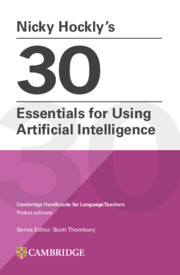B - AI in language teaching and learning
Published online by Cambridge University Press: 22 November 2024
Summary
In this section we explore whether – and if so, how – AI can be used to support language learning. We also look at some of the more controversial uses of AI in learning, such as using emotion AI to measure learner engagement.
6 Learning a language with AI
7 Teaching with generative AI
8 Personalising content for learners
9 Practising English with chatbots
10 Learning with augmented reality
11 Learning with virtual reality
12 Understanding real-time learner engagement through AI
13 Understanding emotion in texts with AI
14 Developing writing skills with AI
15 Assessing learners with AI
Learning a language with AI
Generative AI can be used to enhance already-existing language learning apps, but it has also enabled the development of new mobile and web-based types of tools for language learning.
A few months after ChatGPT was launched, I gave an online conference talk to language teachers about AI. In the question-and-answer session at the end of the talk, one of the attendees asked whether I thought that AI might be a passing fad. My answer? Definitely not. Here's why. Although AI in the form of tools like ChatGPT may have felt like a new development when it first appeared, AI has underpinned language learning software since the early days of Computer Assisted Language Learning (see 1). More recently, learners began using language learning apps on their mobile devices. Many of these apps offer automated language learning activities underpinned by rule-based AI (see 2). For example, some apps specialise in a specific area of language learning, such as grammar or vocabulary, which lend themselves well to a rule-based approach. The advent of data-driven AI (see 2) meant that language learning tools and apps became more sophisticated – machine translation and speech-to-text apps are just two examples of how access to large sets of data training has meant that these apps have got better (i.e., more accurate) over time.
Generative AI as a tool to support learning
In short, AI is not a fad in language teaching – or, indeed, in any other field. The advent of generative AI has had, and will continue to have, an impact on language learning software and approaches in interesting ways. Let's look at some examples of how generative AI can be used to support and enhance what we do in the language classroom.
- Type
- Chapter
- Information
- Publisher: Cambridge University PressPrint publication year: 2024

